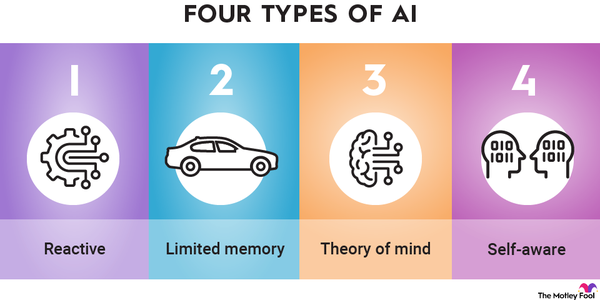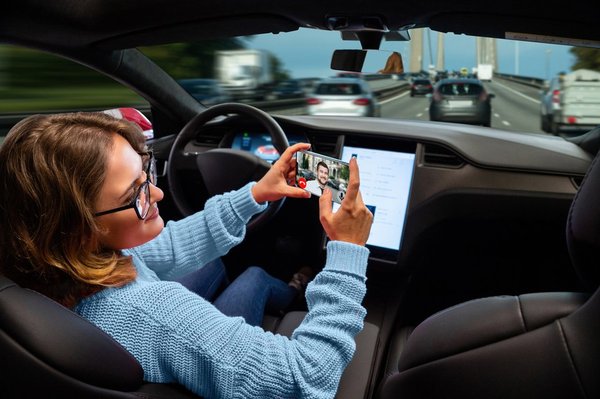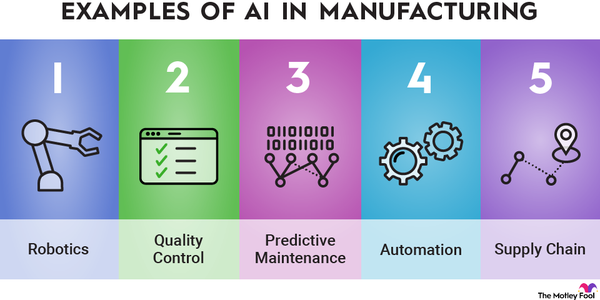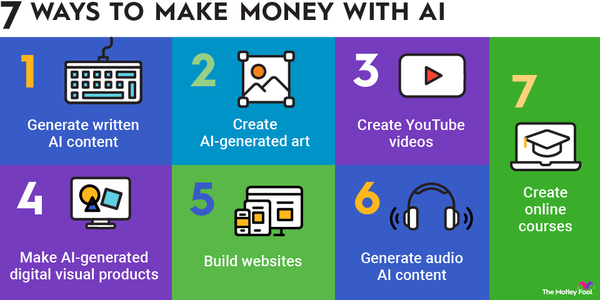Following the launch of ChatGPT, artificial intelligence (AI) has been sweeping the business world, and there are big changes happening with AI in retail.
The retail industry is always evolving according to customer demand and available technology. It's gone from brick-and-mortar to e-commerce to omnichannel, and artificial intelligence helps retailers improve their operations in a number of ways, including demand forecasting and recommendations, to use two more prominent examples.
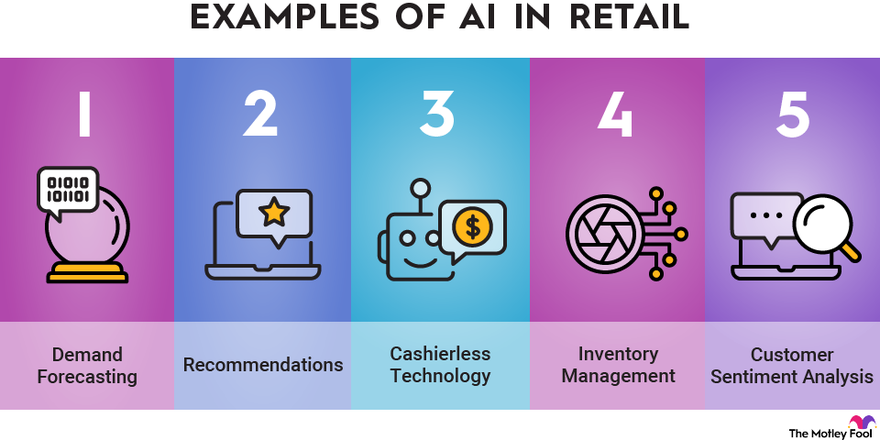
Amazon (AMZN 3.43%) has long embraced artificial intelligence across its business lines, including e-commerce, and other large retailers like Walmart (WMT -0.08%) and Target (TGT 0.18%) have followed suit.
Increasingly, retailers are looking to artificial intelligence to gain advantages through cost management and learning more about how customers engage with their products.
In this look at AI in retail, we'll discuss what artificial intelligence is, how it plays a role in retail, and a number of applications for artificial intelligence in the retail industry.
Artificial Intelligence
What is artificial intelligence?
What is artificial intelligence?
Artificial intelligence is the ability of computers and machines to perform tasks that generally require human intelligence.
This includes formulating answers from disparate pieces of information, recognizing a pattern, and applying it elsewhere.
One of the most common applications in artificial intelligence is machine learning, or the training of an algorithm to recognize something like a part of the body or the difference between a man and a woman.
Many of the AI applications that are used in retail fall under the category of machine learning since making predictions is a key part of the way retailers use technology.
However, we're likely to see more ways in which retailers are embracing AI as artificial intelligence evolves in ways like natural language processing, computer vision, and robotics.
5 uses of AI in retail
5 uses of AI in retail
1. Demand forecasting
1. Demand forecasting
One of the most common applications of AI in retail is in demand forecasting. Understanding which customers want specific products and where they want them is key to helping retailers manage the supply chain, optimize inventory levels, and avoid markdowns.
Demand forecasting is valuable enough that Nike (NKE 0.19%) acquired an AI start-up called Celect for $110 million in 2019 to help it better understand consumer demand in real-time so it can have needed inventory in the right place.
As AI algorithms get more powerful, more companies are likely to embrace the power of demand forecasting using artificial intelligence tools. Additionally, more companies are likely to use AI tools to understand their customer base.
2. Recommendations
2. Recommendations
Another popular way of applying artificial intelligence in retail is through recommendations.
For example, when you buy something on Amazon, the website will suggest other things to buy. The recommendations are based on your past order history, user profile, and other details that AI algorithms process and combine to give the best answer.
Most online retailers are also using some form of recommendation AI to improve the customer experience and sell more products to customers.
Without the natural cross-selling benefits of a store, online retail uses AI to accomplish similar things since retailers don't want to miss an opportunity to upsell a product or recommend a complementary add-on.
3. Cashierless technology
3. Cashierless technology
Retailers are experimenting with ways to ring up customers more efficiently. Self-service registers are the most common technique for automating the checkout process and eliminating lines, but Amazon has moved in a different direction with its Just Walk Out technology.
This AI-based system tracks what customers pull off the shelves with a series of cameras on the ceiling and then charges them when they walk out of one of its Amazon Go stores without the need to stop and pay.
Customers simply scan an app when they walk in, walk out with the items they want, and are automatically charged.
Amazon recently closed eight of its Go stores, a sign that the technology might not be as big of a winner as it hoped. Still, it's deploying the systems in its larger Amazon Fresh grocery stores and its Whole Foods subsidiary. It's also licensing the technology, which could open up a valuable new revenue stream.
4. Automated inventory management
4. Automated Inventory management
Inventory management is a crucial task for any retailer. Companies need to make sure they have products in stock without having too much inventory, which can lead to extra management costs and markdowns.
Walmart, for example, uses AI technologies to help it better manage its inventory. That includes attaching cameras to floor scrubbers, which record inventory levels on shelves and send the information to an AI-powered data center that can help the company make better decisions about its inventory. The so-called inventory intelligence towers are positioned on top of floor scrubbers and take more than 20 million photos of the merchandise on the shelves each day.
AI algorithms receive the images and determine individual brands on the shelves and inventory levels with more than 95% accuracy, helping Sam's Club ensure that it can keep items in stock.
5. Customer sentiment analysis
5. Customer sentiment analysis
As consumer-facing brands, retailers' reputations with the general public are important for their long-term growth prospects, so it makes sense that they would invest in AI technologies for customer sentiment analysis.
Customer sentiment analysis means using AI algorithms to analyze customer feedback, social media posts, and online reviews so they can measure customer sentiment, respond to any complaints before they get worse, and generally identify areas for improvement.
Anheuser-Busch (BUD 0.12%) isn't a retailer, but the recent controversy around Bud Light recently shows why retailers invest time and money into managing their brands and monitoring social media accounts.
AI can not only help monitor these accounts, but it can give suggested responses to complaints, thanks to generative AI, and even respond to them if permitted.
Expect retailers to lean into these AI tools to manage customer relations and to put out fires as they arise in the future.
Related investing topics
Is AI the future of retail?
Is AI the future of retail?
AI is already having an influence on retailers, but it's mostly taken place behind the scenes. While generative AI tools like ChatGPT may offer new ways for retailers to engage with customers, the influence of AI in retail seems likely to remain behind the scenes, especially for brick-and-mortar players.
Still, there are a lot of ways that AI can help these retailers improve their businesses, including through inventory management, product optimization, and demand forecasting, and we should see more examples of AI in online shopping as Amazon experiments with the technology.
If you're looking for ways to get exposure to AI in the retail industry, you can consider the stocks above. Alternatively, you can check out this list of AI stocks or look to an AI ETF if you'd like to own a broad range of companies using artificial intelligence in their businesses.
FAQs
AI in retail FAQs
What are examples of AI in retail?
There are a variety of ways that retail companies are cleverly utilizing artificial intelligence. Some of the more popular uses of AI in the retail industry include demand forecasting, cashier-less technology, automated inventory management, and customer sentiment analysis.
Why is AI good for retail?
The implementation of AI within retail has led to companies being able to greatly improve their relationships with their customers, while also improving overall customer experience and potentially generating cost savings.
How is AI used in retail?
AI is used in a variety of ways in retail. Demand forecasting can help companies understand which customers want which products and at what time. Automated inventory management can be used to help companies ensure they have the right amount of products in stock without generating too much inventory.










